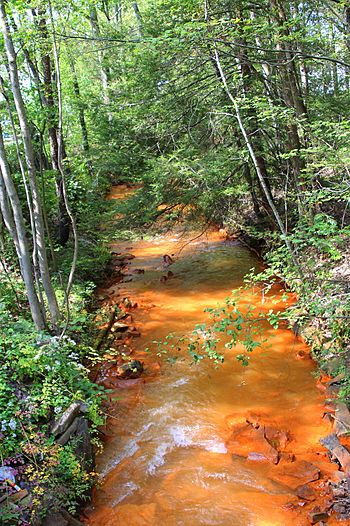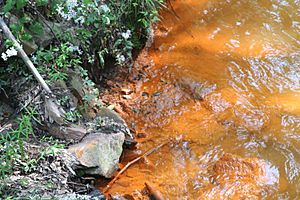Quaker Run (Shamokin Creek tributary) facts for kids
Quick facts for kids Quaker Run |
|
|---|---|

Quaker Run looking downstream in Ranshaw
|
|
| Physical characteristics | |
| Main source | near Pennsylvania Route 61 in Kulpmont, Northumberland County, Pennsylvania between 1,100 and 1,120 feet (335 and 341 m) |
| River mouth | Shamokin Creek in Coal Township, Northumberland County, Pennsylvania 830 ft (250 m) 40°47′02″N 76°31′22″W / 40.7840°N 76.5229°W |
| Length | 3.7 mi (6.0 km) |
| Basin features | |
| Progression | Shamokin Creek → Susquehanna River → Chesapeake Bay |
| Basin size | 3.62 sq mi (9.4 km2) |
| Tributaries |
|
Quaker Run is a small stream, also called a tributary, that flows into Shamokin Creek in Northumberland County, Pennsylvania. It is about 3.7 miles (6.0 km) long. The stream flows through towns like Kulpmont, Mount Carmel Township, and Coal Township.
The area of land that drains into Quaker Run, called its watershed, is about 3.62 square miles (9.4 km2). The stream has one smaller, unnamed stream that flows into it. Quaker Run has been affected by pollution, especially from metals coming from old, unused mines. Sometimes, unwanted substances from waste and rain have also flowed into it.
The stream's banks have walls in some places. There's also a thick, orange-brown layer of iron on the stream bed. However, a special project has helped clean up parts of the stream. It has also created new wetlands nearby. Quaker Run was one of the first places in Pennsylvania where anthracite coal was found.
Contents
Where Quaker Run Flows
Quaker Run starts near Pennsylvania Route 61 in Kulpmont. It flows southwest for a short distance. Then, it crosses Pennsylvania Route 61. After that, it turns west-southwest for over a mile. It then enters Mount Carmel Township and a valley.
The stream continues flowing west for a few miles. It then enters Coal Township. Finally, it reaches the town of Ranshaw. In Ranshaw, it crosses Pennsylvania Route 901. This is where it joins Shamokin Creek. Quaker Run meets Shamokin Creek about 24.68 miles (39.72 km) before Shamokin Creek reaches its own end.
Smaller Streams Joining Quaker Run
Quaker Run does not have any named smaller streams that flow into it. However, it does have one unnamed tributary. This smaller stream is also affected by pollution. People in the area sometimes call this unnamed stream "Dark Run."
Water Quality in Quaker Run
All of Quaker Run is considered polluted. This is mainly due to metals and fine dirt, called siltation, from old, abandoned mines.
Water from some mine areas flows into Quaker Run. Most of the water in Quaker Run comes from these mine discharges. However, the stream also receives water from the Kulpmont Wastewater Treatment Plant. A company also has permission to release stormwater into the stream in Coal Township. In the 1980s, people noticed the stream's water had a bad smell.
Scientists measured the water temperature in Quaker Run in 1999 and 2000. It was between 11 and 14.5 °C (51.8 and 58.1 °F) in Ranshaw. Near Kulpmont, it was 13.5 °C (56.3 °F). The amount of water flowing, called discharge, varied from 5 to 22 cubic feet per second (0.14 to 0.62 m3/s) in Ranshaw. The average flow was about 13 cubic feet per second (0.37 m3/s).
The pH of the water was around 6.2 near Kulpmont. In Ranshaw, it was between 6.3 and 6.8. The water's hardness was also measured. This tells us how many minerals are in the water.
Land and Geology Around Quaker Run
The lowest point of Quaker Run, where it joins Shamokin Creek, is about 830 feet (250 m) above sea level. The highest point, where the stream begins, is between 1,100 and 1,120 feet (335 and 341 m) above sea level.
Quaker Run has a thick layer of iron on its bed. This iron makes the stream look orange or reddish. It is much thicker than in other nearby streams. Long ago, there was a quarry near the stream. Also, old mine tunnels go underneath the stream.
In Ranshaw, the sides of the stream are lined with walls. These walls are old and need repair. The entire area that drains into Quaker Run is about 3.62 square miles (9.4 km2).
A group called the Wildlife for Everyone Endowment Foundation has worked to restore Quaker Run in Coal Township. They have cleaned up 2,000 feet (610 m) of the stream. They also created 3 acres (1.2 ha) of wetlands. The town of Marion Heights is close to where the stream begins.
History and Fun Near Quaker Run
Quaker Run was officially added to the Geographic Names Information System on August 2, 1979. This system keeps track of names for places like streams.
In 1790, a man named Isaac Tomlinson found black stones on his land, where Quaker Run flowed. He discovered that these stones could burn. This made him one of the first people to find anthracite coal in this part of Pennsylvania. The stream was named Quaker Run because Isaac Tomlinson was a member of the Society of Friends, also known as Quakers.
Coal mining later began near Quaker Run. Isaac Tomlinson himself mined coal there in 1810. Another early miner, John Thompson, also operated mines nearby. In the early 1900s, there were several legal cases about pollution in the stream.
Two bridges were built over Quaker Run in 1913. They are both about 23.0 feet (7.0 m) long. They carry State Route 2019 in Ranshaw.
In the 1980s, a fun area was made near Quaker Run. It was built on land that used to be a mining pit. This area included a baseball field and a jogging track. In May 1997, the first "Banks Cleanup" event happened along Quaker Run and Shamokin Creek. In 2014, money was given to help fix the stream's channel. There are also plans for a flood control project for the stream, with new channel walls being built.
Animals and Plants in Quaker Run
The area around Quaker Run is special. It is called a Coldwater Fishery and a Migratory Fishery. This means it's a good place for fish that like cold water. It also helps fish that travel, like salmon, on their journeys.
A long time ago, around 1840, people said the stream was "filled with trout." Trout are a type of fish that live in clean, cold water. However, by 1999, there were no fish of any kind found in Quaker Run. This shows how much the stream's environment has changed due to pollution.



